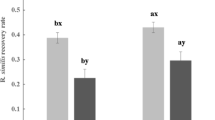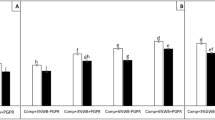Abstract
Field trials were performed in Florida to evaluate tomato and pepper transplants amended with formulations of several plant growth-promoting rhizobacteria (PGPR) in a production system that included soil solarization. Transplants grown in five different formulations of PGPR were planted into plots treated by soil solarization, MeBr fumigation, or untreated soil. Treatments were assessed for incidence of several naturally occurring tomato and pepper pathogens including root-knot nematode (Meloidogyne incognita) and species of Pythium, Phytophthora, and Fusarium. Highly significant increases in tomato and pepper transplant growth occurred in response to most formulations of PGPR tested. Transplant vigor and survival in the field were improved by PGPR treatments in both tomato and pepper. Diseases of tomato caused by root-knot nematodes, Fusarium, Phytophthora, and Pythium were not affected by PGPR treatments. PGPR formulation LS261 reduced numbers of root-knot nematode galls on pepper while pepper root condition was improved with formulations LS213, LS256 and LS261. Individual PGPR strains affected the number of Pythium colonies isolated from pepper roots, but did not affect isolation of Pythium from tomato roots. Greater numbers of colonies of Pythium were isolated from pepper roots in the MeBr treatment and fewest in the solarization treatment. Numbers of colony forming units of Fusarium were significantly higher in the untreated soil than in MeBr fumigated or solarized soil with no effect of PGPR on isolation of Fusarium from either crop. Incidence of wilt symptoms on tomato was significantly lower in MeBr treated plots and highest in the untreated plots. Yield of extra large tomato fruit and total yield increased with PGPR formulation LS256. Yield of pepper was increased with formulations LS255 and LS256. Solarization combined with LS256 on pepper produced yields comparable to MeBr.
Similar content being viewed by others
References
Anonymous 1997 Florida Agricultural Statistics. Fl Ag. Statistics Service, Orlando, FL.
Benhamou N and Thériault G 1992 Treatment with chitosan enhances resistance of tomato plants to the crown and root rot pathogen Fusarium oxysporum f. sp. radicis lycopersici. Physiol. Mol. Plant Pathology 41, 33–52.
Benhamou, N, Lafontaine P J, Nicole M 1994 Induction of systemic resistance to Fusarium crown and root-rot in tomato plants by seed treatment with chitosan. Phytopathology 84, 1432–1444.
Benhamou, N, Kloepper J W, Tuzun S 1998 Induction of resistance against Fusarium wilt of tomato by combination of chitosan with an endophytic bacterial strain: ultrastructure and cytochemistry of the host response. Planta 204, 153–168.
Chellemi D O, Olson S M, Mitchell D J, Secker, I, McSorley, R 1997 Adaption of soil solarization to the integrated management of soilborne pests of tomato under humid conditions. Phytopathology 87, 250–258.
Chellemi D O, Olson S M, Scott J W, Mitchell D J, McSorley, R 1993 Reduction of phytoparasitic nematodes on tomato by soil solarization and genotype. Supplement to Journal of Nematology 25, 800–805.
Cook J R and Baker K F 1983 The Nature and Practice of Biological Control of Plant Pathogens. APS Press, St. Paul MN, 539 pp.
Gilreath J P, Noling J W, Locascio S J, Chellemi D O 1999 Effect of MeBr, 1,3-dichloropropene + chloropicrin with pebulate and soil solarization on soilborne pest control in tomato followed by double-cropped cucumber. Proc. Fla. State Hort. Soc. 112, 292–297.
Hoitink H A J and Fahy P C 1986 Basis for the control of soilborne plant pathogens with composts. Annu. Rev. Phytopathol. 24, 93–114.
Jeffers S N and Martin S B 1986 Comparison of two media selective for Phytophthora and Pythium spp. Plant Disease 70, 1038–1043.
Kloepper J W, Leong J, Teintze M and Schroth M N 1980 Enhanced plant growth by siderophores produced by plant growth promoting rhizobacteria. Nature 286, 885–886.
Kokalis-Burelle N, Rodríguez-Kábana R, Weaver C F and King P S 1994 Evaluation of powdered pine bark for control of Meloidogyne arenaria and Heterodera glycines on soybean. Plant and Soil 162, 163–168.
Komada H 1975 Development of a selective medium for quantitative isolation of Fusarium oxysporum from natural soil. Rev. Plant Protection Research 8, 114–125.
Martinez-Ochoa N, Kokalis-Burelle N, Kloepper J W and Rodríguez-Kábana R 2001 Rhizobacteria, organic amendments, and botanical aromatics for the management of Meloidogyne spp. in tomato transplants. Plant Disease 85: In Press.
Mitchell D J and Kannwischer-Mitchell M E 1992 Methods for Research on Soilborne Phytopathogenic Fungi. Pages 31–38, L L Singleton, J D Mihail and C M Rush, eds. APS Press, St. Paul, MN 265 pp.
Nemec S 1997 Longevity of microbial biocontrol agents in a planting mix amended with Glomus intraradices. Biocontrol Science and Technology 7, 183–192.
Nemec S, Datnoff L E and Strandberg J 1996 Efficacy of biocontrol agents in planting mixes to colonize plant roots and control root diseases of vegetables and citrus. Crop Protection 15 (8), 735–742.
Raupach G S, Liu L, Murphy J F, Tuzun S, Kloepper J W 1996 Induced systemic resistance in cucumber and tomato against cucumber mosaic cucumovirus using plant growth-promoting rhizobacteria (PGPR). Plant Dis. 80, 891–894.
SAS Institute, Inc. 1998 Version 7.01, Cary, NC: SAS Institute, Inc.
Tsao P H 1983 Factors affecting isolation and quantification of Phytophthora from soil. Pages 219–236 In: Phytophthora: Its Biology, Taxonomy, Ecology, and Pathology. APS Press, St Paul, MN.
Vavrina C S 1996 An introduction to the production of containerized vegetable transplants. Univ. FL., Cooperative Extension Service, Bulletin No. 302.
Vavrina C S, Hochmuth G J, Cornell J A, Olson S M 1998 Nitrogen fertilization of Florida-grown tomato transplants: seasonal variation in greenhouse and field performance. HortScience 33, 251–254.
Vavrina C S 1999 The effects of LS213 (Bacillus pumilus) on plant growth promotion and systemic acquired resistance in muskmelon and watermelon transplants and subsequent field performance. Proc. Int. Symp. Stand Establishment 107-111.
Weller D M 1988 Biological control of soilborne pathogens in the rhizosphere with bacteria. Ann. Rev. Phytopathol. 26, 379–407.
Zeck W M 1971 A rating scheme for field evaluation of root-knot nematode infestation. Plazenshutz-Nacht. 24, 141–144.
Zehnder G W, Murphy J F, Sikora E J, Kloepper J W 2001 Applications of rhizobacteria for induced resistance. Europ. J. Plant Pathol. 107 (1), 39–50.
Author information
Authors and Affiliations
Rights and permissions
About this article
Cite this article
Kokalis–Burelle, N., Vavrina, C.S., Rosskopf, E.N. et al. Field evaluation of plant growth-promoting Rhizobacteria amended transplant mixes and soil solarization for tomato and pepper production in Florida. Plant and Soil 238, 257–266 (2002). https://doi.org/10.1023/A:1014464716261
Issue Date:
DOI: https://doi.org/10.1023/A:1014464716261




